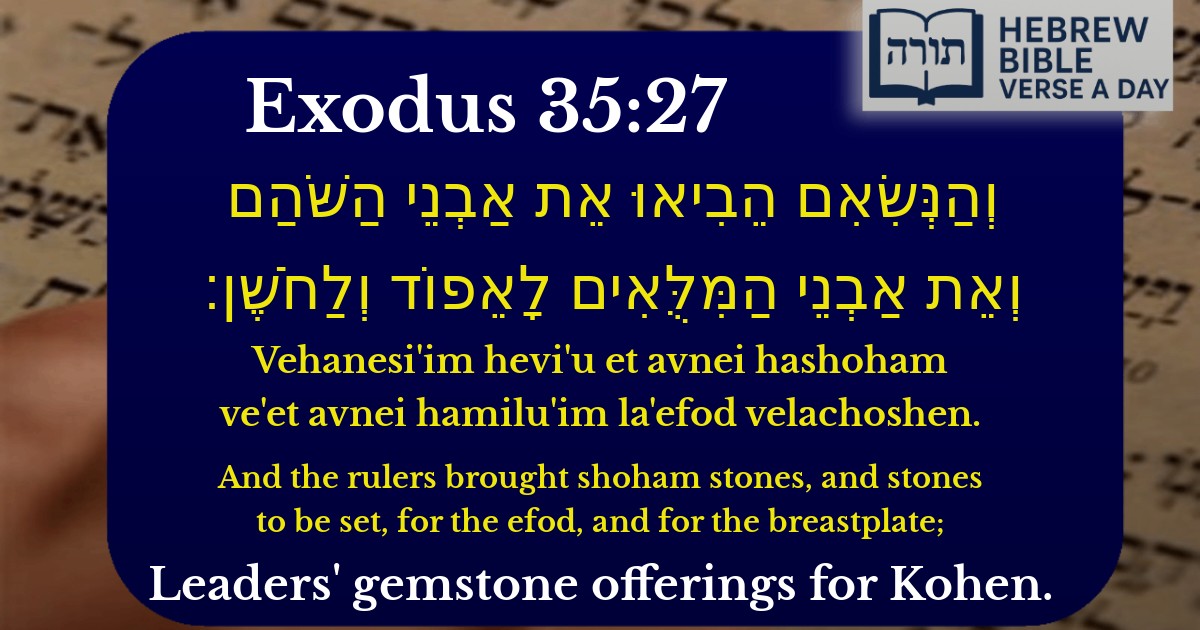Frequently Asked Questions
Q: What are the 'shoham stones' mentioned in Exodus 35:27?
A: The 'shoham stones' (אַבְנֵי הַשֹּׁהַם) were precious stones brought by the leaders of the tribes for the High Priest's garments. According to Rashi, these were likely onyx stones, which were used in the shoulder pieces of the Ephod (Exodus 28:9-12). Each stone was engraved with the names of the 12 tribes of Israel.
Q: Why did the tribal leaders bring these stones for the Mishkan (Tabernacle)?
A: The Midrash (Tanchuma, Pekudei 5) explains that the tribal leaders wanted to contribute something special to the Mishkan. Initially, they held back, thinking others would provide all the needed materials. When they saw the people's generosity exceeded expectations, they personally brought the precious stones to atone for their hesitation.
Q: What is the significance of the stones being brought for the Ephod and Breastplate?
A: The Ephod and Breastplate (Choshen) were sacred garments worn by the Kohen Gadol (High Priest). The stones represented the 12 tribes of Israel being constantly remembered before Hashem (Exodus 28:12, 28:29). The Talmud (Yoma 73a) teaches that the Breastplate's stones would light up to indicate Divine communication.
Q: What lesson can we learn from the leaders bringing these stones?
A: The Rambam (Hilchos Isurei Mizbeach 7:11) derives from this that leaders should set an example in supporting holy causes. Though they initially delayed, they ultimately took personal responsibility. This teaches that it's never too late to contribute to important spiritual matters.
Q: Were these stones used elsewhere in Jewish tradition?
A: Yes, the Talmud (Bava Basra 75a) states that in the future, Hashem will prepare precious stones like these for the righteous. The Midrash (Bereishis Rabbah 69:7) also connects these stones to the foundations of Jerusalem in prophetic visions, showing their enduring spiritual significance.


The Role of the Nesi'im (Rulers) in the Mishkan
The verse (Shemot 35:27) describes how the Nesi'im (tribal rulers) contributed the shoham stones and the stones for the choshen (breastplate). Rashi notes that the Nesi'im initially delayed their contributions, thinking they would supply whatever was lacking after the general donations. However, the people gave so generously that only the precious stones remained, which the Nesi'im then provided. This teaches the importance of not delaying mitzvot, as opportunities may pass.
The Significance of the Shoham Stones
The shoham stones (often identified as onyx) were used for the efod (priestly apron). Ramban explains that these stones, along with the milu'im stones (set stones) for the choshen, were exceptionally precious, symbolizing the elevated status of the kehunah (priesthood). The Midrash Tanchuma (Pekudei 5) connects these stones to the tribes of Israel, as the choshen bore the names of the twelve tribes, representing their unity before Hashem.
Spiritual Lessons from the Stones